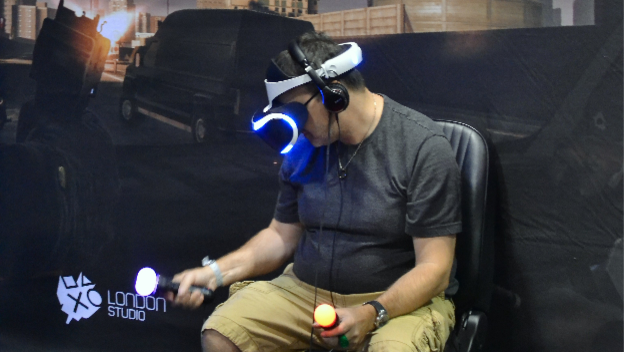I wasn’t at E3, but I have had the pleasure of experiencing VR. It was definitely pretty cool and, had I been alone, I’m sure I would have done all sorts of silly things like talk to NPCs and attempt to wield weapons without motion controls. I admit I experienced a bit of vertigo, but it was such a familiar feeling that I pushed it off as my usual fear of falling. It was something to overcome and convert into a rush of excitement.
That said, I can easily imagine that someone who is not used to the feeling would find it very difficult to overcome. Vertigo, motion sickness, or simulation sickness tends to happen because the room inside the virtual space is not the same size as the room you’re physically in. In addition, if you turn a corner or enter a new room and the simulation lags a little, it makes feel as though you’ve moved less than you really did. Your brain has to readjust, as if to say, ‘Okay, so moving with that much force only gets me that far.” The next time you try it and the controls don’t lag, your brain gets confused, because its new rule has just been thrown out the window.
Our brains can adjust to all sorts of different game physics, but consistency is key. This doesn’t necessarily have to do with motion either. I’m sure you can think of a dozen times where a game countered its own logic and you couldn’t jump that ledge or unlock that door. Quantum Break , for example, refused to be consistent about when and where Jack Joyce’s powers could be used. One moment, you could unlock a door simply by turning back time, the next you couldn’t.
In VR, a contradicting rule like this isn’t so bad, but space and motion are. I’m sure this happens in games a lot more than we think, but we just brush it off as a minor glitch or lagging frame rates. It’s much harder to brush it off in VR. Being immersed in such virtual spaces is too real, thus they need to stay consistent. That, however, is nigh impossible in the gaming industry. Our technology is too delicate to not hiccup now and then. It’s not something developers can anticipate.

In addition, spaces in games do not always make real-world sense. Quite a few horror games, like Layers of Fear , use this to their advantage. If you go straight, turn left, and end up in same room that you were pretty sure was down on another floor, it’s not going to make much sense. But, it’s there so that you do feel uncomfortable and perhaps wonder how the game is going to explain it. Some virtual spaces don’t make real world sense, because they need to give the player an exit point that doesn’t skip any section along the main path. Luckily, as long as spaces make sense in the short term, we seem to get over it pretty fast. Hopefully in VR, we can apply the same short term logic.
However, this means simulation sickness is going to remain pretty much unsolved. Yes, the motion controls could be improved, but that might not be the entire problem. The problem could be caused by fluctuating frame rates or delicate technology. We have to remember that they might not be able to be solved yet. For now, I would highly recommend that Sony, Oculus, and other companies put up warning labels and keep their consumers informed about simulation sickness in VR.
